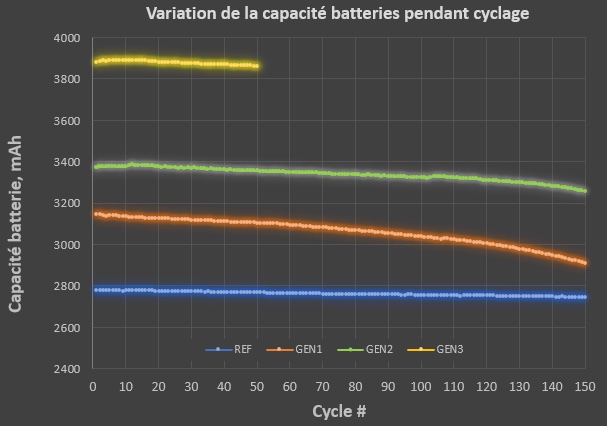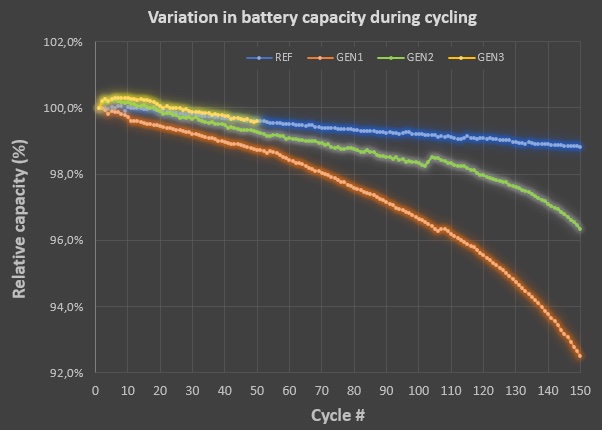- After 50 cycles, 18650 batteries with GEN3 silicon-based material show a 40% capacity improvement over graphite, 25% over GEN1, and 15% over GEN2, with no noticeable degradation [1].
MONTREAL, Canada — HPQ Silicon Inc. (“HPQ” or the “Company”) (TSX-V: HPQ) (OTCQB: HPQFF) (FRA: O08), a technology company specializing in green engineering of silica and silicon-based materials is pleased to announce the latest significant battery milestones achieved by its France-based affiliate, NOVACIUM SAS (“Novacium”).
This announcement covers the results of 50 charge-discharge cycle tests conducted to simulate real-world usage and assess the durability and longevity of the latest batch of Lithium-ion 18650 commercial batteries, made with a blend of graphite and Novacium’s partially optimized GEN3 advanced silicon-based anode material. The 18650 GEN3-based batteries performed remarkably well, with an overall capacity improvement of about 40% compared to a graphite benchmark.
It should be noted here that this performance is 25% higher than that of the previous GEN1 material and 15% higher than that of the GEN2 material, with performance degradation so minimal compared to the graphite benchmark that it falls within the margin of error.
“Producing 18650 battery cells that excel in charge-discharge cycle testing and exceed 4,000 mAh under maximum discharge conditions (July 30th, 2024, release) further confirms our position as a top-tier producer of advanced silicon anode material,” said Dr. Jed Kraiem, COO of Novacium. “Based on these results and the data we’ve gathered, we are confident that we can continue improving our material, and that GEN4-based 18650 batteries could exceed the 4,400 mAh mark.”
ENHANCING BATTERY PERFORMANCE WITH SILICON-BASED ANODE MATERIALS


Graph 1 shows batteries made with Novacium GEN3 materials registered significantly higher capacities over the first 50 cycles than those made with GEN2 and GEN1 materials, as well as the 100% graphite benchmarked batteries.
The average capacity of three 18650 batteries made with Novacium GEN3 materials (yellow line) started at 3,883.0 mAh and decreased to 3,864.8 mAh by the 50th cycle. In comparison, batteries made with Novacium GEN2 materials (green line) started at 3,370.1 mAh and decreased to 3,356.0 mAh, while those with GEN1 materials (orange line) started at 3,145.5 mAh and dropped to 3,105.4 mAh. Finally, the average capacity of three 18650 batteries made with 100% graphite (blue line) started at 2,780.0 mAh and decreased to 2,769.1 mAh by the 50th cycle.
Therefore, after 50 cycles, GEN3 silicon-based batteries show an overall capacity improvement of approximately 40% compared to the graphite benchmark, 25% compared to GEN1 material, and 15% compared to GEN2 material.
SILICON-BASED ANODE MATERIALS DELIVERING GRAPHITE-LIKE BATTERY DEGRADATION RESULTS AT 50 CYCLES


Graph 2 shows that the performance degradation for GEN3 advanced silicon material over 50 cycles is minimal, with a retention of 99.59% compared to the graphite benchmark at 99.61%. This difference falls within the testing protocol’s margin of error.
“Achieving these results with full-size 18650 industrial batteries at 50 cycles further showcases Novacium’s ability to produce advanced silicon anode material that significantly enhances overall battery performance and integrates seamlessly into existing anode manufacturing facilities,” said Mr. Bernard Tourillon, President and CEO of HPQ Silicon Inc. and NOVACIUM SAS. “This seamless integration means that manufacturers can adopt this advanced silicon anode material without needing expensive retooling or process overhauls. It ensures a smoother transition, reduces downtime, and minimizes additional costs, ultimately accelerating the deployment of high-performance batteries in the market.”
REFERENCE SOURCE(S)
[1] Novacium technical team analysis of the data from the ongoing charging and discharging cycle tests conducted at a world-leading university, the name of which is kept confidential for competitive reasons.
About NOVACIUM SAS
Novacium is an HPQ – affiliated company that started in Q3 2022. This green technology startup is based in Lyon, France and is a partnership with HPQ and three of France’s leading research engineers, Dr. Jed KRAIEM PhD, Novacium’s Chief Operating Officer (“COO”), Dr. Oleksiy NICHIPORUK PhD, Novacium’s Chief Technical Officer (“CTO”), and Dr. Julien DEGOULANGE PhD, Novacium’s Chief Innovation Officer (“CIO”). Novacium is a new Research and Development company which allows researchers to develop their own technology in high-added-value fields connected to renewable energy and allows HPQ Silicon Inc. a Canadian company, to expand the depth and reach of its technical team to help develop its silicon and new renewable energy projects.

